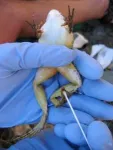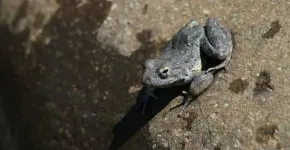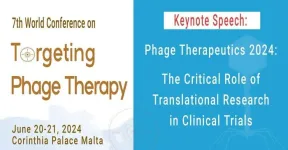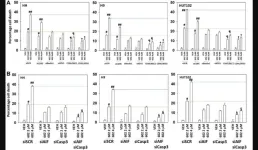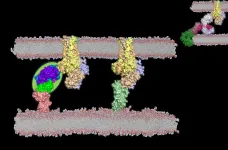(Press-News.org) Glitter is used in a wide array of colors and shapes in apparel, footwear, cosmetics, makeup, handbags, festive decorations, arts and crafts, and jewelry, among many other applications. During the Carnival holidays, hundreds of thousands of Brazilians cover parts of their bodies with it while dancing in the streets. Its brilliance is dazzling but it is considered an emerging pollutant by many scientists: like other microplastics (small plastic pieces less than 5 mm long), it is not filtered by wastewater treatment plants and ends up in rivers and the sea, interfering with aquatic life in various ways.
A study conducted at the Federal University of São Carlos (UFSCar) with FAPESP’s support detected an additional problem: besides plastic, glitter contains metals, typically aluminum, and according to the findings of the study, reported in the New Zealand Journal of Botany, these can hinder the underwater passage of light sufficiently to impair aquatic plant photosynthesis and growth.
The authors of the article focus on the Large-flowered waterweed Egeria densa, a macrophyte (aquatic plant) native to Argentina, Brazil and Uruguay. Macrophytes are visible to the naked eye, serving as food and shelter for many species, providing shade and producing oxygen. They are a key component of biofilters in phytoremediation projects that use plants to detoxify soil, water or air. Some, including E. densa, are widely used for oxygenation and landscaping in aquariums and artificial lakes.
The researchers analyzed the action of glitter in laboratory experiments involving 400 fragments of E. densa incubated in flasks containing water from the Monjolinho reservoir on the campus at UFSCar and common glitter of the type available from retail stores, with an average particle surface area of 0.14 mm2.
They tested four combinations: E. densa in the presence of glitter at 0.04 grams per liter, with and without light; and E. densa in the absence of glitter, with and without light, as control. They analyzed photosynthesis rates using the “light and dark flask” method developed in 1927 and widely used in this type of study. In the light flask, the plant undergoes photosynthesis, producing oxygen as a byproduct. The dark flask is used to measure respiration, where the plant consumes oxygen. The net rate of photosynthesis is determined by comparing the rates of gas exchange in the light and dark flasks.
The experiment showed that photosynthesis rates were 1.54 times higher in the absence of glitter. The reason was that the microplastic particles reduced the amount of light in the water. Respiration was also affected, but not as significantly.
“These findings support the hypothesis we began with, which was that glitter interferes with photosynthesis, possibly owing to the reflection of light by the microplastic particles’ metallic surface,” said Luana Lume Yoshida, first author of the article. The study was part of her scientific initiation project at the Bioassay and Mathematical Modeling Laboratory (LBMM) in UFSCar’s Department of Hydrobiology. Yoshida is currently researching there for a master’s degree in ecology and natural resources.
Sustainable Carnival
“In this experiment, we specifically observed the physical interference of glitter in a species of macrophyte, but there are better-known references in the scientific literature to water contamination and consumption of these particles by other aquatic organisms. We put all the pieces of the puzzle together and were able to describe the functioning of the entire ecosystem, as well as pointing out what can happen throughout the food chain. That’s the key difference of an ecological approach,” said Marcela Bianchessi da Cunha-Santino, last author of the article and one of LBMM’s principal investigators.
“With a robust ‘database’, we’ll be able to think about public policy to foster more conscious consumption of this type of material, but for now it’s important to warn society that changes in photosynthesis rates, however remote they may seem from our lives, are linked to other changes that affect us more directly, such as the decrease in primary production by food chains in aquatic environments [i.e. organisms at the bottom of the food chain]. If there are more sustainable alternatives to glitter, why not switch to these right away?” said Irineu Bianchini Jr., the other co-author of the article and also a PI at LBMM.
About São Paulo Research Foundation (FAPESP)
The São Paulo Research Foundation (FAPESP) is a public institution with the mission of supporting scientific research in all fields of knowledge by awarding scholarships, fellowships and grants to investigators linked with higher education and research institutions in the State of São Paulo, Brazil. FAPESP is aware that the very best research can only be done by working with the best researchers internationally. Therefore, it has established partnerships with funding agencies, higher education, private companies, and research organizations in other countries known for the quality of their research and has been encouraging scientists funded by its grants to further develop their international collaboration. You can learn more about FAPESP at www.fapesp.br/en and visit FAPESP news agency at www.agencia.fapesp.br/en to keep updated with the latest scientific breakthroughs FAPESP helps achieve through its many programs, awards and research centers. You may also subscribe to FAPESP news agency at http://agencia.fapesp.br/subscribe.
END
Metal in glitter impairs aquatic plant growth, study shows
Researchers at the Federal University of São Carlos found that glitter’s metal coating reduced the amount of light penetrating water bodies and hence impaired photosynthesis by the Large-flowered waterweed Egeria densa. The problem may impact primary p
2024-02-26
ELSE PRESS RELEASES FROM THIS DATE:
Scientists assemble a richer picture of the plight and resilience of the foothill yellow-legged frog
2024-02-26
(Santa Barbara, Calif.) — Up to only a few inches in length, with a lemon-hued belly, the foothill yellow-legged frog may seem unassuming. But its range once stretched from central Oregon to Baja California. In 2023, it was listed under the federal Endangered Species Act. Its rapidly decreasing range is due in part to a fungal pathogen called Batrachochytrium dendrobatidis, or Bd, that has devastated amphibians around the world.
A team of researchers, including UC Santa Barbara’s Andrea Adams, has conducted the most comprehensive study to date ...
Neuropsychiatric symptoms predict which patients with mild cognitive impairment develop Alzheimer’s disease.
2024-02-26
As the years add up, it's common to notice slight changes in our ability to remember and think. Older people who have more marked changes than their peers can be diagnosed with mild cognitive impairment (MCI). Currently, we can’t easily predict which of these patients will develop Alzheimer’s disease and which will not.
“It's hard to predict which patients will have a more rapid progression and receive a diagnosis of dementia,” said Maria Vittoria Spampinato, M.D., division director of Neuroradiology at the Medical University of South Carolina.
“It’s important ...
Resurrecting niobium for quantum science
2024-02-26
For years, niobium was considered an underperformer when it came to superconducting qubits. Now scientists supported by Q-NEXT have found a way to engineer a high-performing niobium-based qubit and so take advantage of niobium’s superior qualities.
When it comes to quantum technology, niobium is making a comeback.
For the past 15 years, niobium has been sitting on the bench after experiencing a few mediocre at-bats as a core qubit material.
Qubits are the fundamental components of quantum devices. One qubit type relies on superconductivity to process information.
Touted for its superior qualities as a superconductor, niobium was always a promising ...
Long-term data reveals SARS-CoV-2 infection and vaccine-induced antibody responses are long-lasting
2024-02-26
A long-term analysis conducted by leading microbiologists at the Icahn School of Medicine at Mount Sinai reveals that antibody responses induced by COVID-19 vaccines are long-lasting. The study results, published online in the journal Immunity on February 22, challenge the idea that mRNA-based vaccine immunity wanes quickly.
The emergence of SARS-CoV-2, the virus that causes COVID-19, in late 2019 sparked the global pandemic that is now in its fifth year. Vaccines that were developed at record speed have saved millions of lives. However, the emergence of SARS-CoV-2 variants and waning immunity have decreased ...
Shaping the future of phage therapy: The 7th World Conference on Targeting Phage Therapy in Malta aims to transform clinical trials through translational research
2024-02-26
The 7th World Conference on Targeting Phage Therapy 2024, two-day event dedicated to advancing the field of phage research and therapy will be hosted at Corinthia Palace Malta on June 20-21.
Robert T. Schooley, M.D., Professor of Medicine at the University of California, San Diego, Co-Director of the Center for Innovative Phage Applications and Therapeutics, and member of the Executive Committee for the University of California Disaster Resilience Network, will introduce the messages and strategies behind phages therapy 2024.
His talk titled “Phage Therapeutics 2024: Essential Translational Research Components for ...
GZ17-6.02 with bexarotene kills mycosis fungoides cells
2024-02-26
“The present studies were performed to extend our knowledge of GZ17-6.02 biology from that known in solid tumor cell types such as prostate cancer cells to liquid tumor cell types, for example, mycosis fungoides.”
BUFFALO, NY- February 26, 2024 – A new research paper was published in Oncotarget's Volume 15 on February 8, 2024, entitled, “GZ17-6.02 interacts with bexarotene to kill mycosis fungoides cells.”
In this new study, researchers Michael R. Booth, Laurence Booth, Jane L. Roberts, Cameron West, and Paul Dent from Virginia Commonwealth University and Genzada Pharmaceuticals investigated the therapeutic agent GZ17-6.02, composed of curcumin, ...
University of Tennessee Health Science Center professor awarded $1.5m to study 'root causes' of disparity in breast cancer survival of Black women and white women
2024-02-26
Memphis, Tenn. (February 26, 2024) – Shelley White-Means, PhD, a professor of Health Economics in the Department of Interprofessional Education and the director of the Consortium for Health Education, Economic Empowerment and Research (CHEER) at UT Health Science Center, recently received a $1.5 million, four-year grant from the National Institute on Minority Health and Health Disparities to explore the root causes of the disparity in breast cancer survival of Black women compared to white women.
Dr. White-Means and a team will look beyond the social determinants of health to explore what she terms “the intersectionality of race, ...
Steering and accelerating electrons at the microchip scale
2024-02-26
Stanford researchers are getting closer to building a tiny electron accelerator based on “accelerator-on-a-chip” technology with broad potential applications in studying physics as well as medical and industrial uses.
The researchers have demonstrated that a silicon dielectric laser accelerator, or DLA, can now both speed up and confine electrons, creating a focused beam of high-energy electrons. “If the electrons were microscopic cars, it’s as if, for the first time, we’re steering and we have our foot on the gas,” said Payton Broaddus, PhD ’23 in electrical engineering and the lead author on a paper published on ...
City of Hope scientists devise novel strategy to seek and destroy leukemia stem cells
2024-02-26
FINDINGS
Scientists at City of Hope, one of the largest cancer research and treatment organizations in the United States, have devised an innovative approach to target and destroy hard-to-kill leukemia stem cells. The journal Blood published the preclinical findings today.
By overcoming challenges, such as drug resistance and treatment relapse common to patients with acute myeloid leukemia (AML), the therapy method could provide a less toxic and more effective approach for older and sicker patients who don’t quality for stem cell transplants — currently the only cure for AML available.
Type II interferon (IFNy), a substance produced by immune cells, disrupts ...
Laser-focused look at spinning electrons shatters world record for precision
2024-02-26
NEWPORT NEWS, VA – Scientists are getting a more detailed look than ever before at the electrons they use in precision experiments.
Nuclear physicists with the U.S. Department of Energy’s Thomas Jefferson National Accelerator Facility have shattered a nearly 30-year-old record for the measurement of parallel spin within an electron beam – or electron beam polarimetry, for short. The achievement sets the stage for high-profile experiments at Jefferson Lab that could open the door to new physics discoveries.
In a peer-reviewed ...
LAST 30 PRESS RELEASES:
Valvular heart disease is common in cancer patients but interventions improve survival
When socially responsible investing backfires
Cuffless blood pressure technologies in wearable devices show promise to transform care
AI-based tool predicts future cardiovascular events in patients with angina
Researchers map how the cerebellum builds its connections with the rest of the brain during early development
Routine scans could detect early prostate radiotherapy changes
Fairness in AI: Study shows central role of human decision-making
Pandemic ‘beneath the surface’ has been quietly wiping out sea urchins around the world
Tea linked to stronger bones in older women, while coffee may pose risks
School feeding programs lead to modest but meaningful results
Researchers develop AI Tool to identify undiagnosed Alzheimer's cases while reducing disparities
Seaweed based carbon catalyst offers metal free solution for removing antibiotics from water
Simple organic additive supercharges UV treatment of “forever chemical” PFOA
£13m NHS bill for ‘mismanagement’ of menstrual bleeds
The Lancet Psychiatry: Slow tapering plus therapy most effective strategy for stopping antidepressants, finds major meta-analysis
Body image issues in adolescence linked to depression in adulthood
Child sexual exploitation and abuse online surges amid rapid tech change; new tool for preventing abuse unveiled for path forward
Dragon-slaying saints performed green-fingered medieval miracles, new study reveals
New research identifies shared genetic factors between addiction and educational attainment
Epilepsy can lead to earlier deaths in people with intellectual disabilities, study shows
Global study suggests the underlying problems of ECT patients are often ignored
Mapping ‘dark’ regions of the genome illuminates how cells respond to their environment
ECOG-ACRIN and Caris Life Sciences unveil first findings from a multi-year collaboration to advance AI-powered multimodal tools for breast cancer recurrence risk stratification
Satellite data helps UNM researchers map massive rupture of 2025 Myanmar earthquake
Twisting Spins: Florida State University researchers explore chemical boundaries to create new magnetic material
Mayo Clinic researchers find new hope for toughest myeloma through off-the-shelf immunotherapy
Cell-free DNA Could Detect Adverse Events from Immunotherapy
American College of Cardiology announces Fuster Prevention Forum
AAN issues new guideline for the management of functional seizures
Could GLP-1 drugs affect risk of epilepsy for people with diabetes?
[Press-News.org] Metal in glitter impairs aquatic plant growth, study showsResearchers at the Federal University of São Carlos found that glitter’s metal coating reduced the amount of light penetrating water bodies and hence impaired photosynthesis by the Large-flowered waterweed Egeria densa. The problem may impact primary p

